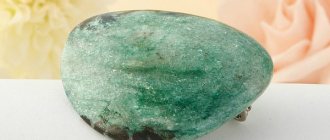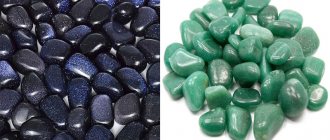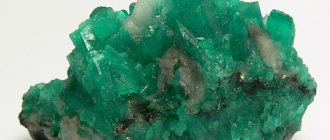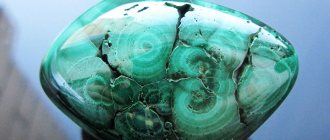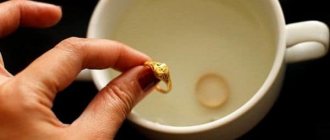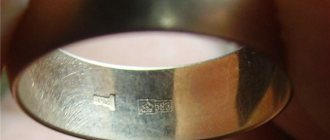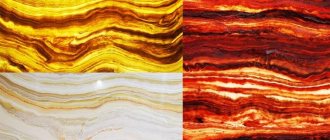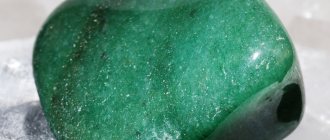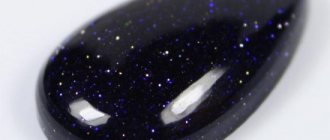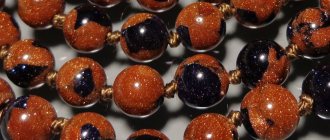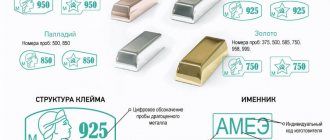| Category | Quartz |
| Title in English | Aventurine |
| Formula | SiO2 |
| Group | Fine-grained quartzite |
| Color | Green, Red-brown |
| Stroke color | White |
| Shine | Fatty |
| Transparency | Opaque |
| singonia | Trigonal |
| Hardness | 7 |
| Cleavage | Missing |
| Density, g/cm³ | 2.6 g/cm³ |
| Kink | Conchoidal |
| origin of name | The name of the stone comes from the Latin word “per avventura”, which translates as “accident”. Somewhere in the 18th century, on the territory of the Italian island of Murano, there lived a worker who, by chance, dropped several copper sections into a bowl of molten metal. An interesting red glow and accompanying seething appeared. This is how the first sample of goldstone or glass made from aventurine appeared. |
| Morphology | The rock is characterized by the presence of minerals of plugged and isometric forms. |
Place of Birth
Australia, Norway, Chile, Austria, Brazil, India, Spain, and the USA are countries where deposits of various types of aventurine are located.
For example, aventurines from America are known as “golden stones.” The green variety of this mineral is common in India. The latter was also very popular among the ancient Chinese as the sacred “Emperor Stone”, since it was from it that the state seal was made.
— Advertising —
Since 1810, aventurine began to be mined in the south of the Urals.
Story
The Italian word "aventura", which is the parent word for the name of the stone, translates as "happiness" and "adventure".
According to legend, this name was given to the stone in the 16th century in honor of its resemblance to the artificial material that Italian craftsmen obtained when copper filings got into the glass melt. The sparkling material looked very similar to natural stone. The mineral has been known since ancient civilizations. In ancient India, the stone served as a talisman for fakir and snake charmer. In the Middle Ages, Indian merchants brought aventurines to Europe, where their beauty was appreciated.
Aventurines have been known in Russia since the 18th century, and became especially popular after the discovery of deposits in the Urals. The mineral was used to make jewelry, vases, candlesticks, and cutlery. A vase with a height of 150 cm and a diameter of about 250 cm has been preserved in the Hermitage.
Application
The stone is excellently used in jewelry and souvenirs. Rings and rings with aventurine in a silver frame will look great on both women and men.
In addition, the stone looks great on beads, earrings, pendants, pendants and sometimes tiaras.
Also, aventurine is used to create various boxes, make figurines and figurines.
The stone has a cabochon cut shape, is not picky about its edges, and can only be polished occasionally. Often, the mineral is used in its “raw” form. For lovers of handicrafts, pebbles can be found in the form of spherical beads, hearts, drops, pyramids.
Physico-chemical characteristics
— Advertising —
The hardness of aventurine reaches 6-7, the mineral is well polished. The density is 2.65.
The color of aventurine depends on the composition of the mineral; it varies from red-brown, brownish, gray-yellow to green.
The stone is translucent and has a glassy sheen. The sparkling-golden tint is given to it by inclusions of mica, goethite and hematite, and cracks with iron hydroxides.
Classification of stones
The stone got its name from the French “aventurine”, which in turn was derived from the Latin “adventurus”, which means “to happen”.
Aventurine is a variety of quartz characterized by fine grain. This is a rock based on quartz interspersed with small flakes of mica or chloride or hematite.
Alternative names are aventurine spar, sunstone, aventurine labradorite.
Actually, the texture and color of aventurine and the severity of its radiance depend on what type of inclusions are present in quartz, what their size is and how uniform they are.
The color and shine are influenced by the presence of chromophoric minerals; their presence can range from 5 to 40 percent. Minimum values are typical for light-colored stones; they contain muscovite and rutile; such shades are distinguished by the greatest radiance. Thus, the most sparkling aventurine is colored honey-yellow. Cherry-colored stones, on the contrary, are almost completely devoid of shimmer; in such stones the proportion of chromophoric minerals reaches 40%.
The most popular classification of aventurines is by color:
- Brown. The color is uniform, the texture is dense, some specimens have reddish tints.
- Honey. The surface is porous and has a high level of overflow.
- Cherry. The shimmer is dull, the texture is transparent.
- Pink. The rock is dense with porous formations, the shine is almost invisible.
- White with red pattern. It is distinguished by a contrasting color, the red color is present in the form of stripes or spots.
- Green. One of the most common colors, the texture is dense, homogeneous, and the shine is low.
- Light golden. The appearance of the stone is distinguished by the presence of chaotically placed stripes of a golden hue.
- Blue. A beautiful stone with a scattering of flickering sparks, dark color and dense texture.
Varieties of aventurine
- Belocherite is a mineral with a fine-grained dense structure; color options can be different; its distinctive feature is its flexibility in polishing; an almost mirror-like shine can be achieved. The stone got its name from the Belaya River, which flows in Altai, where the belocherite deposit is located near the town of Zmeinogorsk.
- Fuchsite is aventurine, which is distinguished by inclusions of mica sparkles of an emerald green hue. The name of the stones is given in honor of Johann Fuchs, a mineralogist from Germany.
Chemical composition and physical properties of aventurine
In terms of its chemical composition, aventurine is nothing more than silicon oxide.
- Formula - SiO2
- Syngony - trigonal
- Hardness – 6-7 points, according to the Mohs scale
For reference: The Mohs scale is a set of minerals taken as a standard for determining the hardness of a stone. The minerals are arranged in order of increasing hardness, which was determined by scratching.
- Density – 2 – 2.6 g per cubic cm.
- The fracture is conchoidal.
Magic properties
Among the abilities of aventurine, such as the ability to lift mood, increase sensuality and sharpen emotions are noted.
This stone becomes an excellent source of inspiration for creative people, but it can harm those who bear great responsibility and distract from business. According to legend, aventurine inspires its owner with self-confidence and helps to acquire wealth. This is one of the strongest energetic stones, changeable and mysterious.
Astrologers call it a sign of pure love, as it intensifies high feelings. At the same time, aventurine is capricious; it is not recommended to wear it without taking it off. The stone is removed during changes in the phase of the moon, washed regularly with warm water and dried in the sun.
Colors
The following varieties of aventurine are distinguished by color:
- Honey-yellow color with a granular structure and uniform coloring with a bright “sparkle.”
- Brown color with a dark pink tint, fine-grained, dense.
- Golden red color. Externally it resembles Venetian glass. Brightly colored and intensely shiny.
- Pink color with a fine-grained structure and low sparkle.
- Spotted-striped cherry-white color, combines spots and stripes of cherry-brown on white or pinkish.
- The white color consists of light golden stripes on white.
- Green color, bright, shining.
Brief mineralogical information
Aventurine is a mineral that is silicon (IV) oxide SiO2. This is quartzite with a characteristic fine-grained structure. Various inclusions of unevenly dispersed mica make it possible to classify the gem as an unusual stone. Interestingly, the color of the mineral can vary. Numerous photos of the mineral itself and jewelry are proof of this.
What does real aventurine look like? For example, specimens from the Ural mines are reddish-brown due to inclusions in the form of hematite particles, while those from India and Austria are dark blue. There are known deposits in India where the green-tinged mineral is mined due to inclusions of fuchsite. There are specimens of sunny yellow color. It was yellow aventurine that received the name “golden sand”. The smallest scaly inclusions, shimmering, create the illusion of fine-grained golden sand.
Artificial aventurine
As such, there is no artificial aventurine, but other minerals are found under this name.
Most often it is a glass imitation, the so-called aventurine glass. It is obtained by adding oxides of cuprum, ferum, chromium, and cobalt to the glass alloy, resulting in the formation of a rich color palette from green, red-brown, blue to black. The production of such glass was known in Ancient Egypt, but later this knowledge was lost. Red-brown glass under “aventurine” was obtained only in the 16th century on the island of Murano (Venice). Imitations of aventurine look brighter than natural stones; they are often set in gold and used in jewelry.
Compatibility with other gems
The stone belongs to two elements at once: Earth and Water. It is difficult for twins to find a suitable match because they do not combine well with other minerals. Aventurine is not recommended to be worn together with fire stones: pyrope, heliodor, ruby and diamond. They will suppress its impact.
You should not wear minerals corresponding to Air: topaz, rock crystal, tourmaline, amethyst, sardonyx, etc. Combination with Water will produce a storm, so the gems will enhance each other’s negative effects.
Other minerals related to Earth and Water will work well. These are agate, jade, jasper, turquoise, jadeite, heliotrope, opal, emerald, etc.
Turquoise and jadeite harmonize perfectly with aventurine.
How to distinguish a fake?
A counterfeit of natural aventurine is evidenced by excessive brightness and an abundance of sparkles.
Natural aventurines are not so bright, saturated colors are not typical for them. The color of natural aventurines is dominated by pastel colors; they are pale and uniform. Glass imitations are painted in a bright golden-brown or blue-black color with glitter. The main distinguishing features are:
- Shine. Artificial aventurine contains large and uniform sparkles, but in a real stone they are dull.
- Sequin placement. On a fake, the sparkles are distributed evenly over the entire surface, while on a natural stone they are located in sections or zones.
- Brightness. For example, in one pair of earrings, natural stones will vary slightly in color, while imitation stones will have an even and uniform color.
- Natural stone is also not completely smooth.
Reasons for imitations
Unfortunately, gone are the days when it was possible to discover a treasured gemstone on a simple path. But the population of our planet is increasing. And along with him, his need for the “star stone” grows. The mineral is used to create jewelry such as brooches, beads, earrings, rings, and pendants. More massive objects of art are not currently produced from this mineral. This is due to the fact that this stone is rarely found in the form of large formations (a formation is considered large if its dimensions are at least half a meter in diameter).
Interesting fact
In the 18th century, aventurine was discovered on the territory of the Southern Urals, the dimensions of which made it possible to carve three vases from it, each of which was 146 cm high and 246 cm wide. One of these vases is still in the State Hermitage Museum (city) . Saint Petersburg).
What to choose: aventurine or aventurine glass
If you set out to purchase jewelry made from real aventurine, you should be prepared for the following:
- its color will not be bright (most often aventurines have a weak color of the grains);
- blisters of natural aventurine are located unevenly in space and differ in the degree of gloss;
- large formations of aventurine are rare, and, therefore, the price of products made from it is high.
Now regarding aventurine glass. Although it is a counterfeit of aventurine, it also has its advantages:
- The first plus is the price. Compared to the cost of natural aventurine, the cost of its analogue is relatively low.
- The second plus is the color scheme. Thanks to modern advances in glassmaking, the creators of aventurine glass can give it any color required by the customer.
- Plus the third is the brightness of the shine. If you want to get a piece of jewelry that resembles the light of distant stars, you should also consider aventurine glass. The fact is that in the original the sparkles are scattered chaotically and rarely form “star” clusters.
- Plus the fourth one is size. Due to the low cost of star glass and the ease of its processing, you can order products from manufacturers, the size of which is limited only by the capabilities of your wallet. This could be a perfume bottle for your beloved woman or a life-size statue of yourself. It's up to you to choose.
Aventurine and zodiac sign
Aventurine products are suitable for such zodiac signs as Cancer, Pisces, Scorpio, Taurus, Capricorn, Virgo.
In matters of love, he helps those born under the sign of Libra, Aquarius and Gemini.
The stone is definitely not suitable for all representatives of the fire element; it is especially not recommended for Aries, Leo and Sagittarius.
Interesting Facts
- During the Gold Rush, aventurine was considered a powerful talisman for prospectors searching for precious metals. It was believed that the larger the aventurine in a miner's pocket, the more gold he could find.
- The ancient Greeks called brown aventurine pressed gold, and considered it a gift from the Earth goddess Hera.
- The largest deposits of aventurine were discovered in Taganay in 1825; two vases were created from the found stone. One of them is kept in the Hermitage, its diameter is 2 m 46 cm, its height reaches 1 m 46 cm, and its weight is 4 tons.
- The magical properties of aventurine are very contradictory. On the one hand, the mineral promises good luck in gambling and business. On the other hand, it attracts love, positive emotions, helps to gain self-confidence, a clear mind and calm thoughts.
